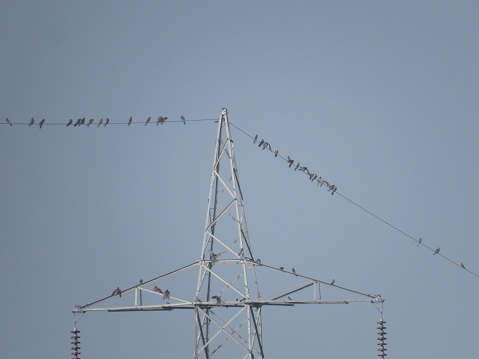Naga, Wokha and Pangti have reached Africa last week, Center for Conservation, Education and Research has confirmed. They left Doyang in Nagaland (India) on and after November 7. Naga and Pangti were detected over the Arabian sea on November 14 morning and Wokha was way behind poised to enter Odisha air space from the Bay of Bangal on that morning. The trio of Amur falcons and their group are now on the 'largest and most hazardous ' stretch of their migration as they head towards the warmer climate of South Africa.
The trio of Amur falcons were named after local places and fitted with the sattelite devices on November 7 in Pangti village (Doyang) of Wokha district in Nagaland. The three birds left Doyang after their release and were tracking with sattelite tagging. The birds arrive the forest on the banks of the water reservoir of Doyang hydroelectric project in Wokha district of Nagaland every year from Mongolia, North of China and Siberia (Eastern Russia) to roost for some days before moving on.
Naga flew over Assam and Bangladesh, crossed the Bay of Bangal before entering the sky of Andhra Pradesh and Kernataka from there, before leaving the mainland to soar over the Arabian sea. Pangti followed the same route till Andhra Pradesh, but then flew over Maharastra in India. Wokha has crossed Somalia on last Friday and entered Kenya. Pangti, already has arrived the new continent and now in Tanzania. Naga is whirling away time in Kenya's Tsavo National Park. Amur falcon moves in folk of thousands. Since trio have reached Africa, it is clear that other birds of the folk also have reached the new continent safely. So it certain that other Amur Falcons from Nagaland and Assam also have reached the new winter safely. They left Assam on second and third week of November 2013.

The Amur falcons keep coming in small groups from the first week of October till the end of November with the ones coming early leaving first. There are still thousands of Amur falcons at the roosting site at Doyang and they are expected to move by the end of this month. The marathon migrationof the species was a mystery and one route has been confirmed this time with sattelite tagging. But the route of return has not been confirmed yet and it is expected to be confirmed it with sattelite devices in trio. The new technology will shed more light on these birds and their complete migratory route. The cost of each device is about Rs 7 lakh.
Migratory birds are learning to adapt with changed environment on transit. A large number of Amurn Falcons are seen in Borbori (Nellie) and Umrangchu in Assam taking shelter on electric wires rather than trees to get their prey or food. In this state it is observed that the bird prefers to sit and search for food sitting in the high voltage electric wire during the day time. Amur Falcons live in folks prefer to sit in the electric wire because the number of trees are decresing and they can sit together in the wire.The bird takes food or hunt its prey sitting on wire over the paddy field easily. Moreover the bird prefer electric wire as safe and less disturbed place.
Except this year thousand of Amur falcons had been slughtered in the state of Nagaland for years. For some years it has been observed that a lage number of birds taking shelter in the state of Assam, neighbouring to Nagaland. The bird take shelter in Assam as passage migratory birds for one and half month or two months. For last few years it has been noticed taking them shelter on high and long electric wire over the paddy fields.
Fortunately, it is remarkable that marking a significant milestone for conservation of Amur falcons in the northeast Indian state of Nagaland, three villages in Wokha district have been working to save the migratory raptor in Doyang Reservoir - its largest roosting site in the world. With mass annual hunt potentially threatening the species, a resolution has been cleared by the villages to penalise offenders, this year onward.
Nick P Williams, Program Officer, Birds of Prey, UNEP who has been monitoring the conservation and scientific activities including the tagging of satellite transmitters at roosting site in Doyang, Nagaland. Concerned authority and organisations in Nagaland were informed that the UNEP was closely observing the safe passage of the migratory birds. On hearing the news of the mass massacre last year here at Nagaland, the executive secretary of UNEP wrote to the Minister of forest and environment, Government of India. Principal Chief Conservator and Head of the Forest Department of Nagaland Mr M Lokeshwara Rao stated that the villagers of Wokha helped tapping the birds for tagging. It delighted him that the people who once hunted the birds have now turned conservationist.
- 13835 reads









Add new comment